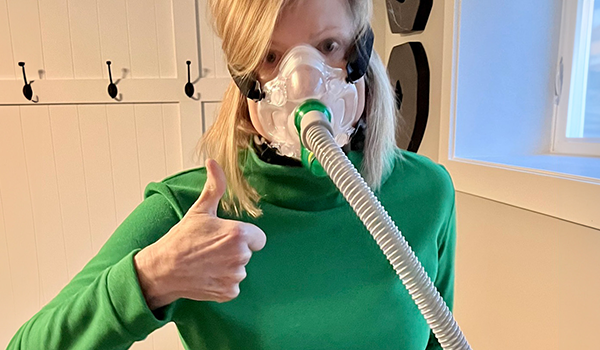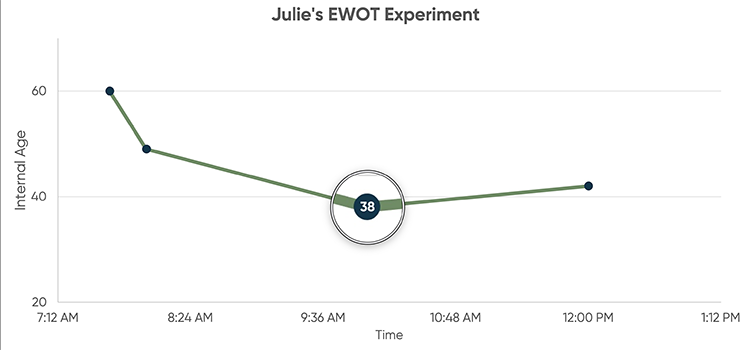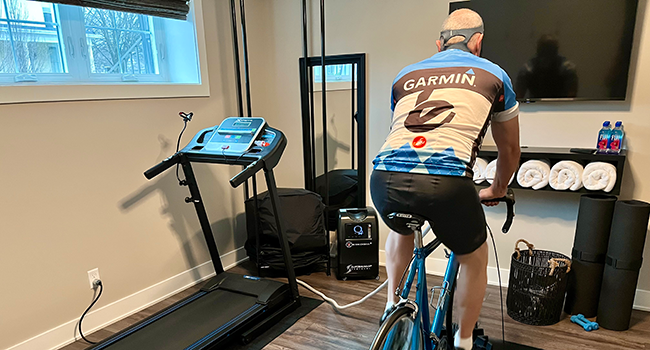March 18, 2024
My Experience with EWOT

By Julie Gregory, Chief Health Liaison for Apollo Health
After years of hearing Dr. Bredesen extoll the benefits of Exercise With Oxygen Therapy (EWOT), I finally took the plunge and decided to splurge on a system. Before I share my impression, let me give you a brief overview of EWOT (pronounced E-watt). Simply put, it involves breathing high levels of oxygen while exercising. We typically breathe air that is comprised of 21% oxygen, but when using an oxygen concentrator and fitted high-flow EWOT mask, we can increase the amount by at least four times, helping to deliver oxygen very efficiently throughout your entire body and brain.
This practice has been used in Germany and by athletes worldwide since the mid-1970s. Manfred von Ardenne, a German physicist and inventor, was focused on helping cancer patients when he realized that many patients, not just cancer patients, had oxygen and energy-deficient cells. That discovery ultimately led to his creation of the Oxygen Multistep Therapy, which we now call EWOT. Von Ardenne authored a lengthy book that some call “Oxygen Bible,” entitled Oxygen Multistep Therapy, with hundreds of medical references and thousands of studies to support the use of oxygen to optimize health. Unfortunately, the book is no longer in print, but thanks to the Internet Archives, you can access it in its entirety here. If you’re curious, you can also read over 200 papers authored by von Ardenne on PubMed.
Von Ardenne’s research suggests that an interesting phenomenon occurs when you exercise with oxygen; it reduces inflammation and swelling of all microvessels in the body. Microvessels are the smallest blood vessels in the body, including arteries, capillaries, and arterioles. When these microvessels begin to narrow — the body and brain are no longer able to effectively deliver oxygen, blood, and nutrients to the organ systems. This is where EWOT can be very helpful.
But the benefits of EWOT don’t stop there. In fact, when I first began my research and started reading about the many benefits of EWOT, it started to remind me of the magic elixir that the medicine man sold to Aunt Bee in the old Andy Griffith show. It almost seemed too good to be true.
The Benefits of EWOT Include:
● Increases blood circulation throughout the body and brain
● Improves oxygenation
● Reduces inflammation
● Increases ATP (adenosine triphosphate, a fuel source for your cells)
● Improves immunity
● Increases energy levels
● Accelerates recovery from injuries and workouts
● Supports lung function and the respiratory system
● Supports cardiovascular function
● Promotes detoxification
I approached my EWOT experiment somewhat skeptically. After reading all of the hype, I expected a miraculous and immediate improvement. It didn’t quite work that way. After my first session, I felt fine — maybe I had a little more energy. I wasn’t really sure. I used it off and on for a few weeks until I got comfortable doing 20-minute sessions of HIIT (high-intensity interval training), interspersing fast walking with intervals of sprinting every three minutes. I liked it but didn’t notice a huge benefit. Then life got in the way, and I ended up taking a two-week break to care for my dying uncle. (See Lessons from Uncle Carl.)
My EWOT Experiment
After his death, I was more motivated than ever to fight against Alzheimer’s and give EWOT a decent trial. This time, I wanted actual data so I could better assess its effect. Given that it’s supposed to improve vascular health, I decided to do pre-and post-testing with my iHeart gadget, which tests arterial stiffness using aortic pulse wave velocity. Your score is reported as an “internal age.” This is a device that we recommended in The End of Alzheimer’s Program. I’ve been using it on and off for the past five years. I typically score below my biological age (around 5 to 7 years) but have never been able to budge the numbers too far, even with pretty extreme exercise.

Even I was stunned by the results of my experiment. In the line graph above, you can see that my internal age was 60 at the beginning of the experiment. (Given that I’m almost 62 and hadn’t exercised for two weeks, that was better than I expected.) After a 20-minute session of HIIT, I was pretty shocked to see that my internal age dropped by 11 years. I had never seen that big of a drop with any exercise or other intervention. I repeated the iHeart testing two hours later to see how durable the effect would be. I was astonished to see that my internal age had dropped an additional 11 years for an all-time low of 38 — whoa! I followed up by testing two hours later (four hours post-exercise) and still retained an 18-year overall improvement. There’s clearly something to this. Despite my initial reluctance, after this one experiment I’m a believer. I suspect that Dr. Bredesen is onto something important for our population.

Ready to Get Started?
If you’re lucky enough to have a facility near you that offers EWOT, give it a try before you make an investment. I was unable to find any locations near me, so I decided to purchase a system. I settled on the HyperMax system (pictured above) because it has a small footprint (2’x2’) compared to many of the other available options. The 900-liter oxygen bag is pictured in the corner with the much smaller oxygen concentrator next to it. (The bag is almost fully deflated in this picture, but it inflates to almost the top of my basement ceiling.) The tubing stretches to accommodate either my treadmill or the road bike on a trainer.
Necessary Equipment and Considerations
1. An oxygen concentrator You can sometimes choose between a concentrator that concentrates 5 LPM (liters per minute) or 10. Both will do the job, but a 10 LPM concentrator will work much faster to fill your bag — less than 90 minutes vs. 3 hours. Because it’s important to keep the bag free from contaminants (like mold), it’s helpful to have a unit with a HEPA filter. Note for larger athletes: Even with our 900-liter bag fully inflated and a 10 LPM concentrator running, my husband (who sprints on his bike for the full workout) can only get 15 minutes before the bag is empty.
2. An oxygen bag Make sure your bag is free from any toxic materials as you will be breathing this directly into your lungs. Many have medical grade lining. Some hang from the ceiling while others are placed into a frame. Measure carefully, as these are typically very large. It’s important to ensure that your designated room (especially the ceiling height) can accommodate your bag.
3. Specially fitted EWOT mask You must use a specially fitted high-flow EWOT mask that allows for oxygen in and carbon dioxide out. Many systems come with a mask, but some make that a separate option. Be sure to carefully follow the instructions for measuring to determine the correct size.
4. Exercise equipment Traditionally, aerobic equipment (such as a treadmill or bike) is used, but I’ve also experimented with strength training and have seen YouTube videos of others doing the same.
LiveO2 is among one of the more popular options. It offers an adaptive contrast feature that allows you to switch between oxygen-concentrated air and oxygen-depleted air. They claim to have better results, but I couldn’t find any published research. Dr. Bredesen doesn’t recommend this option (unless you’re training for high altitude) because he is concerned about creating a hypoxic environment for those who may already have depleted energetics. If you are using a traditional EWOT system without adaptive contrast and want to experiment with cycling oxygen levels, you could always experiment with a short breath hold on the exhale. For those who decide to purchase a standard EWOT system, the One Thousand Roads system is among the most economical options, starting at $1,699 for everything.




